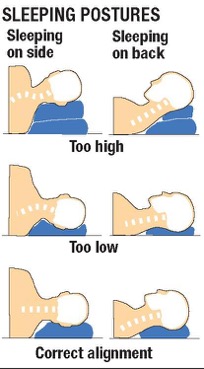Wellfie Wednesday Tip #94: Find a Pillow that is Juuuuust Right!
/Happy Wellfie Wednesday! Welcome back! This week is brought to you by Diana (@DianaKlatt).
This pillow’s too high. This pillow’s too low. This pillow is juuuuust right.
A good night’s sleep is crucial to a good day. Sleep wrong and you feel out of balance all day long. So, let’s start at the beginning. Depending on the type of sleeper you are (side, back, stomach, hanging from the ceiling…) your pillow height and type changes. The ultimate goal is to have your spine in proper alignment. Of these types of sleeping positions, back and side are the best options.
Side sleepers:
Get a pillow that is higher under your neck than your head to help keep your spine straight during sleep. A curved pillow is best for this. If you find yourself tucking your arm under your pillow it’s probably because your pillow is not elevating your head appropriately.
Back sleepers:
You want your head to be at a 15 degree angle. So obviously you should sleep with a goniometer and a partner to constantly check your degrees of flexion… just kidding, or am I?
Stomach sleepers:
Beware! Stomach sleeping has multiple associated problems. Sleeping in this position causes your back to be arched and your neck to be tilted to the side, twisting your spine – both not ideal for optimal blood flow and spine alignment. How can you try to train yourself out of sleeping on your stomach? According to studies the best way to prevent stomach sleeping is to bend the elbow and knee on the side you turn your head towards and put a pillow under your hip and armpit, and then if THAT doesn’t work, you can try to tape a tennis ball to the front of your shirt so you’re not comfortable on your stomach.
But wait! Pillows aren’t just for your head! You can place pillows under your knees (back sleeping) or between your knees (side sleeping) or other places to help with proper alignment. So how do you travel and keep pillows consistent? You either accept that you’re going to have some weird neck feels or you travel with your own pillow... I tend to go with the first option (which is what has sparked this topic) but I have suggestions for travel pillows if you’re interested!
Be sure to check your pillow tonight! Thanks again for all of the #WellfieWednesday support, be sure to post your pictures this week and tag the WW crew members in your post (@TheFuelPhysio, @Eric_in_AmERICa, @AaronPerezPT, @DianaKlatt, @kuhnalyssa_spt) and keep the wave of healthy change going!
- WW Crew
Sources:
https://www.health.harvard.edu/pain/say-good-night-to-neck-pain
https://www.ncbi.nlm.nih.gov/pmc/articles/PMC4274296/




